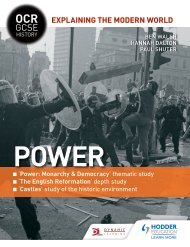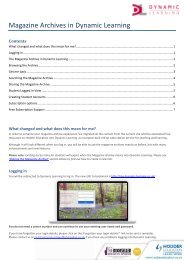GEOGRAPHY
WJEC-Eduqas-B-GCSE-Geography-sample-material
WJEC-Eduqas-B-GCSE-Geography-sample-material
Create successful ePaper yourself
Turn your PDF publications into a flip-book with our unique Google optimized e-Paper software.
THEME<br />
1<br />
Features in the book:<br />
Chapter 1<br />
Rural-urban change in the UK<br />
THEME<br />
Introducing Cardiff<br />
1<br />
Chapter 1 people could live further from their place of work. The<br />
city began to spread outwards as new suburban housing<br />
Rural-urban<br />
Cardiff is the largest city in Wales. It has a population was built.<br />
change<br />
Suburban sprawl,<br />
in<br />
as<br />
the<br />
this process<br />
UK<br />
is called,<br />
of 350,000. Like many cities in the UK, Cardiff went filled in the spaces between the edge of the city and<br />
through a period of rapid growth between around 1850 existing small villages such as Radyr and Whitchurch.<br />
people could live further from their place of work. The<br />
and 1920 as people moved Introducing into the city Cardiff to find work in These villages are now part of the urban area of Cardiff.<br />
city began to spread outwards as new suburban housing<br />
industries related to the Cardiff sale is of the coal largest from city Cardiff in Wales. docks. It has a population was built. Suburban sprawl, as this process is called,<br />
Terraced houses were of built 350,000. to provide Like many homes cities for in these UK, Cardiff Between went the filled mid-1980s in the spaces and between today Cardiff the edge has of the gone city and<br />
dock workers and many through of these a period homes of rapid can growth still between seen around through 1850 a third existing phase small of villages growth. such This as Radyr time and new Whitchurch. housing<br />
and 1920 as people moved into the city to find<br />
today in the inner urban areas close to the city centre. was work built in on<br />
These<br />
the old<br />
villages<br />
industrial<br />
are now<br />
sites<br />
part of<br />
once<br />
the urban<br />
occupied<br />
area of<br />
by<br />
Cardiff.<br />
industries related to the sale of coal from Cardiff docks.<br />
The process of physical growth and population growth is the dock-related industries in Butetown next to Cardiff<br />
Terraced houses were built to provide homes for these Between the mid-1980s and today Cardiff has gone<br />
known as urbanisation. dock workers and many of these homes can still Bay. be seen These through sites are a third known phase as of brownfield growth. This sites. time new Because housing<br />
Key terms are<br />
today in the inner urban areas close to the city centre. these sites are was within built on the old inner industrial urban sites area once of Cardiff occupied the by<br />
highlighted During throughout the period 1930 The to process the mid-1980s of physical growth Cardiff and population growth population is of the this dock-related zone has industries been rising, in Butetown a process next to known Cardiff<br />
and went defined through in student-<br />
a second known phase urbanisation. of growth. Better public as re-urbanisation. Bay. These sites are known as brownfield sites. Because<br />
friendly transport language and in more widespread car ownership meant that<br />
the Glossary, boosting<br />
During the period 1930 to the mid-1980s Cardiff<br />
went through a second phase of growth. Better public<br />
students' geographical<br />
transport and more widespread car ownership meant that Brecon<br />
vocabulary GEOGRAPHICAL and<br />
SKILLS<br />
understanding<br />
GEOGRAPHICAL SKILLS<br />
Brecon Beacons<br />
National Park<br />
Describing locations<br />
To describe a location means to be able to<br />
pinpoint something To on describe a map. a Describing location means a to be able to<br />
Mertyr Tydfil<br />
N<br />
location on an Ordnance pinpoint Survey something (OS) on map a map. is Describing a<br />
Mertyr Cwmbran Tydfil<br />
easily done by giving location a grid on reference. an Ordnance However, Survey (OS) map is<br />
Chepstow Cwmbran<br />
easily done by giving a grid reference. However,<br />
Chepstow<br />
describing a location on a map that has no grid<br />
describing a location on a map that has no grid M4<br />
Cardiff Newport<br />
M4<br />
Cardiff<br />
lines requires a different technique.<br />
Newport<br />
lines requires a different technique.<br />
M4<br />
M4<br />
Clear explanations<br />
Bridgend Bridgend<br />
Bristol<br />
First, you need to give a broad indication of<br />
Bristol<br />
First, you need to give a broad indication of<br />
and examples allow<br />
Barry Barry<br />
the location by describing the location in which by describing part of in the which part of the<br />
students to learn<br />
map the viewer should map be the looking. viewer should Always be looking. use Always use<br />
Bristol Channel<br />
Westonsuper-mare<br />
kilometres<br />
0 20<br />
and practise the<br />
geographical terms such as ‘in south Wales’ rather Bristol Channel<br />
Westonsuper-mare<br />
kilometres<br />
geographical terms such as ‘in south Wales’ rather<br />
geographical skills than ‘at the bottom of the map’ or ‘near to the<br />
than ‘at the bottom Bristol of the Channel’. map’ or ‘near to the<br />
Figure 1 The location of Cardiff<br />
they need to achieve<br />
Bristol Channel’.<br />
Figure 1 The location of Cardiff<br />
their potential<br />
Then, to describe the exact location, you should<br />
Year Population Year Population<br />
Then, to describe the use exact another location, significant you place should on the map and give:<br />
Year Population Year Population<br />
use another significant ■ ■ the place distance on the from map that and other give: place in kilometres 1801 1,870 1931 226,937<br />
■<br />
■■<br />
the distance from ■ the direction using points of the compass.<br />
that other place in kilometres 1801 1851 1,870 18,352 1931 1941 226,937 No data<br />
■■<br />
the direction using For points example, of on the Figure compass. 1, Bridgend is 28km to<br />
1851<br />
the 1861 48,965 1951 243,632<br />
18,352 1941 No data<br />
west of Cardiff.<br />
1871 57,363 1961 283,998<br />
For example, on Figure 1, Bridgend is 28km to the 1861 48,965 1951 243,632<br />
1881 96,637 1971 293,220<br />
west of Cardiff.<br />
1871 57,363 1961 283,998<br />
2<br />
Describing locations<br />
these sites are within the inner urban area of Cardiff the<br />
population of this zone has been rising, a process known<br />
as re-urbanisation.<br />
Brecon<br />
Brecon Beacons<br />
National Park<br />
M5<br />
Gloucester<br />
1891 128,915 1981 285,740<br />
1881 96,637 1901 164,333 1971 1991 293,220 296,900<br />
1891 128,915 1911 182,259 1981 2001 285,740 305,353<br />
1901<br />
1921<br />
164,333<br />
222,827<br />
1991<br />
2011 346,000<br />
296,900<br />
1911<br />
Figure 2 Population of Cardiff. Source: National Census<br />
182,259 2001 305,353<br />
1921 222,827 2011 346,000<br />
Figure 2 Population of Cardiff. Source: National Census<br />
M5<br />
Gloucester<br />
M5<br />
M5<br />
0 20<br />
N<br />
2




